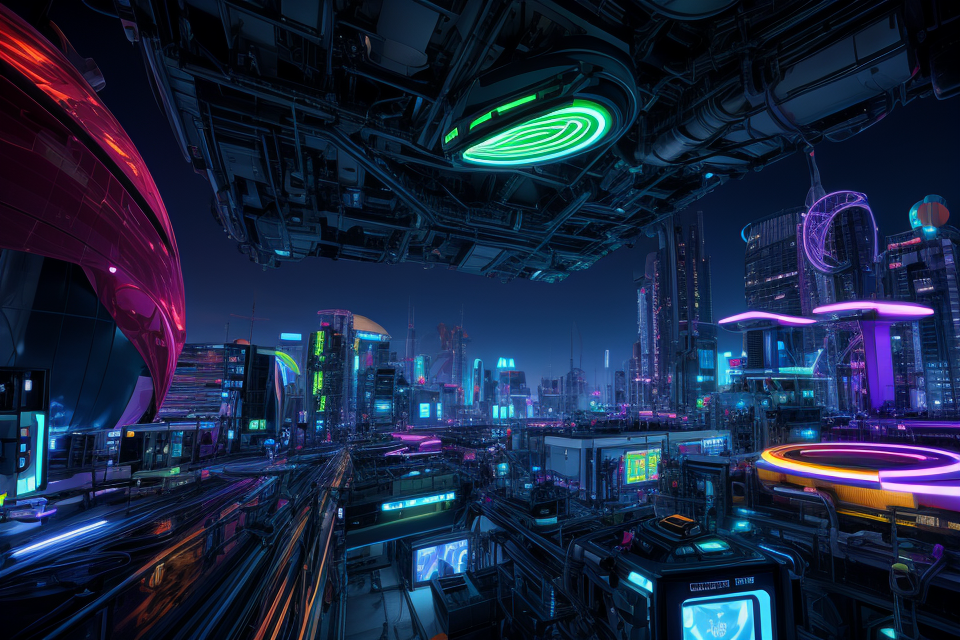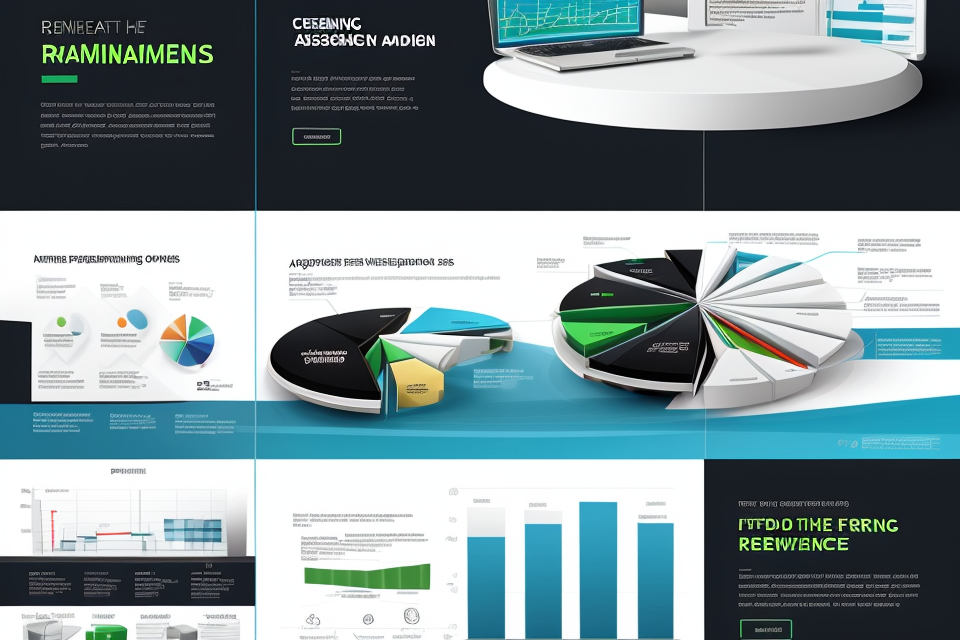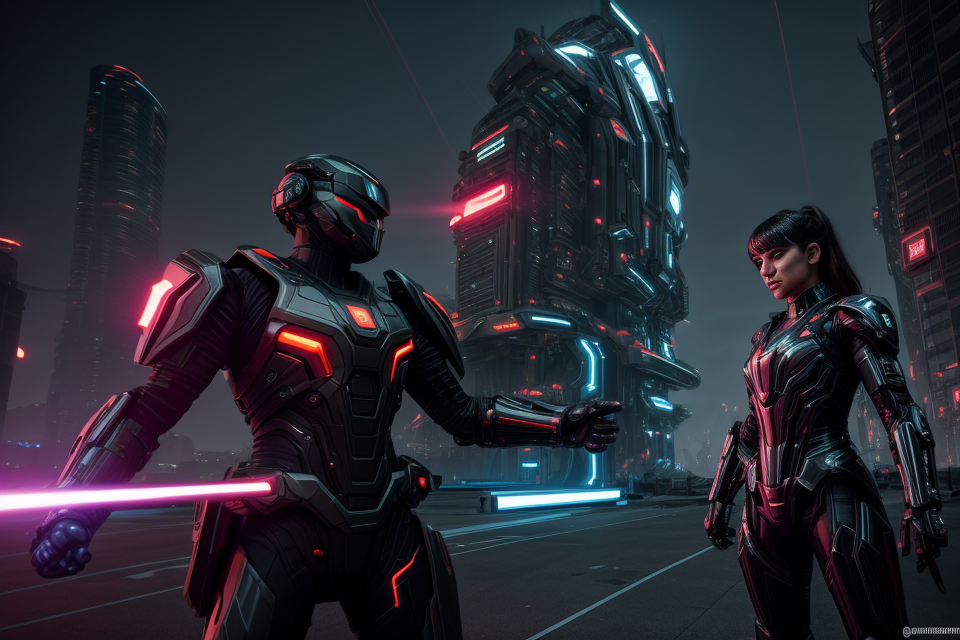
Ray tracing has been the gold standard in computer graphics for decades, providing realistic lighting and shadows that have revolutionized the way we experience video games and movies. However, as technology continues to advance, some are beginning to question whether there might be something better than ray tracing. In this article, we’ll explore some of the alternatives to ray tracing and examine whether they might offer a superior solution for creating realistic graphics. We’ll look at rasterization, a technique that uses a different approach to generate images, and examine how it compares to ray tracing. We’ll also examine some of the benefits and drawbacks of each method and discuss how they might be used in different contexts. Whether you’re a gamer, a developer, or just someone who’s interested in the latest advances in computer graphics, this article is sure to provide some fascinating insights into the world of graphics rendering.
What is Ray Tracing?
Origins and Development
Ray tracing, a technique for generating realistic images, has been a topic of interest for many years. Its origins can be traced back to the 1940s when it was first conceptualized by the mathematician, Cornell University Professor, John McCarthy. However, it wasn’t until the 1970s that the first practical ray tracing algorithms were developed, thanks to the work of researchers such as Harold Leach and Thomas Porter.
During the 1980s and 1990s, significant breakthroughs were made in the field of ray tracing. The introduction of more powerful computers and the development of new algorithms allowed for the creation of more realistic images and animations. In addition, the development of hardware-accelerated ray tracing, such as the PhotoRealistic RenderMan, helped to make ray tracing more accessible to the general public.
In recent years, there have been significant advancements in both hardware and software, allowing for even more realistic and detailed images. For example, the development of the NVIDIA GeForce RTX 2080 Ti, a graphics processing unit (GPU) specifically designed for ray tracing, has made it possible to create realistic lighting and shadows in real-time.
Overall, the development of ray tracing has come a long way since its conception in the 1940s. The breakthroughs in the 1980s and 1990s, combined with the advancements in hardware and software in recent years, have made it possible to create incredibly realistic images and animations.
How It Works
Ray tracing is a technique used in computer graphics to generate realistic images by simulating the behavior of light. The basic principle of ray tracing is to simulate the way light travels through a scene, taking into account the properties of surfaces, the position and intensity of light sources, and the viewer’s perspective.
A ray tracing system consists of several components, including the camera, objects in the scene, and light sources. The camera is responsible for capturing the image, while the objects in the scene interact with the light sources to determine their appearance. Light sources can be either virtual or real, and they affect the scene by illuminating the objects in the scene.
One of the key limitations of ray tracing is its computational complexity. As the number of objects and light sources in a scene increases, the number of calculations required to simulate the behavior of light becomes prohibitively large. This makes it difficult to achieve real-time performance, and limits the complexity of the scenes that can be rendered.
Another challenge with ray tracing is the need for accurate and detailed models of surfaces and materials. This requires a significant amount of data and computation, and can be difficult to achieve in practice. Additionally, the need for complex and detailed models of light sources can make it difficult to achieve realistic and natural-looking lighting effects.
Despite these challenges, ray tracing remains a powerful and versatile technique for generating realistic images in computer graphics. However, as the demand for more efficient and scalable rendering techniques continues to grow, researchers and developers are exploring alternatives to ray tracing that may offer better performance and flexibility.
Alternatives to Ray Tracing
Rasterization
Rasterization is an alternative rendering technique to ray tracing that has been around for several decades. It is a process of converting a 3D model into a 2D image or bitmap by projecting it onto a plane. This technique was first introduced in the 1960s and has since become a popular method for rendering computer graphics.
How it works
Rasterization works by dividing the 3D model into small rectangles called pixels. Each pixel represents a small area of the image and contains a color value. The rasterization process then projects each pixel onto a 2D plane, creating a bitmap image. This image can then be displayed on a screen or other output device.
Advantages and disadvantages
One advantage of rasterization is that it is relatively fast and efficient, making it a popular choice for real-time rendering applications such as video games. It is also a mature technology with a long history of development and improvement.
However, rasterization has some limitations. One of the main drawbacks is that it can produce visible artifacts, such as jagged edges and polygon wobbling, which can be particularly noticeable in high-resolution displays. This is because rasterization does not take into account the depth of each pixel, which can lead to distortion and blurring.
Another limitation of rasterization is that it can be less accurate than ray tracing when it comes to simulating light and shadows. Ray tracing can produce more realistic lighting and reflections, which can be important for applications such as architectural visualization or product design.
Despite these limitations, rasterization remains a popular and useful technique for many applications. Advances in hardware and software have helped to mitigate some of its limitations, and it continues to be a valuable tool in the field of computer graphics.
Screen Space Reflection
Screen Space Reflection (SSR) is a technique used in computer graphics to simulate the appearance of mirror-like surfaces in a scene. It works by calculating the reflection of the scene‘s environment on the surface of objects in the scene. This technique has gained popularity as an alternative to ray tracing, especially for real-time rendering applications.
Origins and Development
The concept of SSR dates back to the early days of computer graphics, with the first implementation appearing in the late 1970s. Since then, the technique has evolved and been refined through the development of various algorithms and methods, leading to its widespread use in modern computer graphics.
SSR works by rendering the reflection of the scene‘s environment on the surface of objects in the scene. The reflection is calculated using a camera that is set up to capture the reflection of the scene on the object’s surface. The reflection is then blended with the object’s surface to create the final image.
One of the main advantages of SSR is its efficiency. The technique is much faster than ray tracing, making it well-suited for real-time rendering applications. Additionally, SSR can produce high-quality images that are similar to those produced by ray tracing.
However, SSR also has some disadvantages. One of the main drawbacks is that it can produce artifacts, such as ghosting and blooming, which can reduce the quality of the final image. Additionally, SSR is not well-suited for scenes with complex lighting or shadows, as these can be difficult to simulate accurately.
Procedural Techniques
Origins and Development
Procedural techniques have been used in the field of computer graphics for many years. These techniques involve the generation of 3D models and scenes algorithmically, rather than through manual construction. The development of procedural techniques has been driven by the need for efficient and flexible methods of creating complex graphics.
How it Works
Procedural techniques work by defining a set of rules or algorithms that generate a 3D model or scene. These rules can be based on mathematical equations, statistical models, or other methods. The resulting models and scenes are often highly detailed and can be easily modified or customized.
One of the key benefits of procedural techniques is their ability to generate complex geometry and textures algorithmically. This can be particularly useful in applications such as video games, where the need for realistic environments and characters is critical.
Advantages and Disadvantages
Procedural techniques offer several advantages over traditional modeling methods. They are often more efficient, as they require less manual labor and can generate complex geometry and textures quickly. They are also highly flexible, as they can be easily modified or customized to meet specific needs.
However, procedural techniques also have some disadvantages. They can be more difficult to understand and manipulate than traditional modeling methods, as they involve a more complex set of rules and algorithms. They may also require more processing power and memory, as they generate 3D models and scenes algorithmically.
Overall, procedural techniques offer a powerful alternative to ray tracing and other traditional modeling methods. While they may have some drawbacks, they offer many benefits for applications that require highly detailed and customizable 3D graphics.
Vector-Based Rendering
Vector-based rendering, also known as vector rendering, has its roots in the field of computer graphics, dating back to the early days of 2D graphics. It emerged as a response to the limitations of raster-based rendering, which relied on pixels to create images. Vector-based rendering offers an alternative approach by using mathematical equations to represent images as vectors.
In vector-based rendering, images are represented as a series of mathematical equations, rather than pixels. These equations define the shape, color, and position of the image’s elements. The rendering process involves interpreting these equations and using them to generate the final image. This method is particularly useful for creating scalable graphics, as it allows the image to be resized without losing quality.
One of the primary advantages of vector-based rendering is its scalability. Vector images can be scaled up or down without losing quality, making them ideal for applications that require high-resolution output, such as print media or billboards. Additionally, vector graphics are typically smaller in file size compared to raster graphics, making them more efficient for web use and storage.
However, vector-based rendering has its limitations. One of the main challenges is the complexity of the algorithms required to generate detailed images. Vector-based rendering is particularly challenging for photorealistic images, as it can be difficult to accurately represent the subtle gradations of color and shading found in real-world scenes. Furthermore, vector-based rendering may not be suitable for real-time applications, as the processing requirements can be quite high.
Overall, vector-based rendering offers a unique alternative to ray tracing, particularly for applications that require scalable, high-quality graphics. While it may not be suitable for all use cases, it remains an important tool in the field of computer graphics.
Comparison of Alternatives
Performance
When it comes to real-time rendering, the performance of a rendering technique is a crucial factor to consider. This section will compare the performance of ray tracing with some of its alternatives.
Comparison of Different Techniques
Ray tracing is a technique that simulates the behavior of light in a scene. However, it is not the only technique that can be used for real-time rendering. Other techniques include rasterization, which traces the edges of objects in a scene, and path tracing, which traces the path of light as it bounces off surfaces in a scene.
Factors Affecting Performance
The performance of a rendering technique is affected by several factors, including the complexity of the scene, the number of objects in the scene, and the number of lights in the scene. The rendering technique that is best suited for a particular scene will depend on these factors.
Future Developments
Researchers are constantly working on improving the performance of rendering techniques. For example, recent developments in machine learning have led to the creation of deep learning-based rendering techniques that can render scenes in real-time with high quality. These techniques have the potential to improve the performance of real-time rendering in the future.
Realism
Ray tracing is renowned for its ability to create hyper-realistic visuals, but it’s not the only game in town. Let’s explore some alternatives and compare their realism capabilities.
Comparison of different techniques
While ray tracing is the go-to technique for achieving photorealism, other methods such as rasterization, screen-space reflections, and computational reflection are viable alternatives. Each has its own strengths and weaknesses, and they vary in terms of the level of realism they can achieve.
Factors affecting realism
Several factors contribute to the overall realism of a technique. These include:
- Accuracy: How well the technique can represent the physical properties of light and its interaction with objects.
- Complexity: The amount of computation required to render a scene.
- Artistic interpretation: The degree to which the technique can be manipulated to create stylized or artistic effects.
Future developments
As technology continues to advance, so too will the capabilities of these alternative techniques. Researchers are exploring new algorithms and methods to enhance realism while reducing the computational requirements. These developments could lead to exciting new possibilities for rendering and visual effects in the future.
Applications
Differences in Gaming
In the gaming industry, the choice between ray tracing and its alternatives largely depends on the desired level of realism and performance. While ray tracing offers more accurate lighting and reflections, it can also have a significant impact on hardware requirements. On the other hand, rasterization techniques such as shadow mapping and screen-space reflections (SSAO) are more computationally efficient but may not achieve the same level of realism.
Differences in Architecture
In architecture, ray tracing is commonly used for visualizing the effects of light on building designs. However, alternatives such as global illumination algorithms like radiosity and photon mapping can offer similar results with less computational overhead. These techniques are particularly useful for large-scale projects where real-time rendering is not a requirement.
Differences in Film and Animation
In the film and animation industry, ray tracing is often used to create realistic lighting and shadows in computer-generated scenes. However, alternatives such as physically-based rendering (PBR) and virtual reality (VR) can offer similar results with different trade-offs. PBR focuses on reproducing the behavior of materials in a more realistic way, while VR offers a more immersive experience by simulating the physical properties of light.
Choosing the Right Technique for a Specific Project
When choosing between ray tracing and its alternatives, it is important to consider the specific requirements of the project. Factors such as the desired level of realism, hardware constraints, and budget should be taken into account when making a decision. In some cases, a combination of techniques may be necessary to achieve the desired results.
FAQs
1. What is ray tracing?
Ray tracing is a rendering technique that simulates the behavior of light to create realistic images. It works by tracing the path of light rays as they bounce off various surfaces in a scene, taking into account factors such as color, reflection, and refraction. The result is a highly accurate representation of how light interacts with objects in a scene, leading to more realistic images than other rendering techniques.
2. What are the advantages of ray tracing?
Ray tracing offers several advantages over other rendering techniques. First, it produces highly realistic images that closely mimic how light behaves in the real world. Second, it can handle complex lighting scenarios, such as global illumination and reflections, with ease. Third, it can produce accurate shadows that are difficult to achieve with other techniques. Finally, it can be used to create highly detailed and accurate renders, making it ideal for applications such as architectural visualization and product design.
3. What are some alternatives to ray tracing?
There are several alternatives to ray tracing, including rasterization, screen space reflections, and ambient occlusion. Rasterization is a simpler rendering technique that does not take into account the behavior of light, but instead relies on pre-calculated texture maps to create images. Screen space reflections use a mirror-like effect to simulate reflections, rather than tracing the path of light rays. Ambient occlusion is a technique that shades areas of an image based on the proximity of nearby surfaces, creating a sense of depth and shadow.
4. Which method is better?
The best method depends on the specific needs of the project. Ray tracing offers the most realistic and accurate results, making it ideal for applications such as architectural visualization and product design. However, it can be computationally intensive and may not be suitable for real-time applications or games. Rasterization is faster and more suitable for real-time applications, but it cannot achieve the same level of realism as ray tracing. Screen space reflections and ambient occlusion are useful for adding reflective and shadowy elements to an image, but they are not as comprehensive as ray tracing. Ultimately, the choice of method will depend on the specific requirements of the project.


